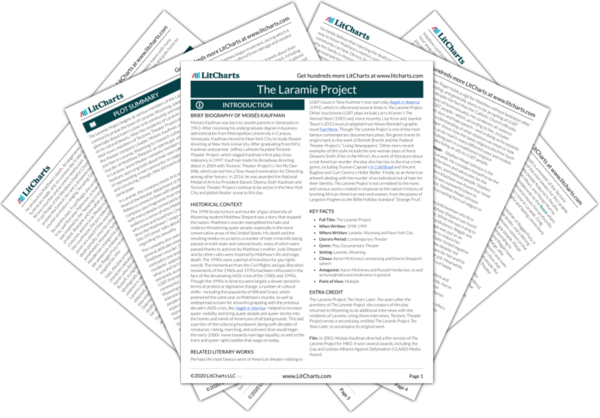Summary
Analysis
The narrator gives the audience an update on the case against Aaron McKinney and Russell Henderson, stating that they both pled not guilty. Their girlfriends were charged with accessory to murder and also pled not guilty. The narrator then introduces Rob Debree, the chief investigator of the case. Rob talks about how disturbing it was to see Matthew Shepard fighting for his life, when Rob usually deals with dead bodies.
The narrator’s practical updates about the legal situation of Aaron and Russell gets the reader up to speed on their case. Rob Debree’s comments about working with a living victim emphasize how the violence Matthew endured has caused long, drawn out suffering.
Themes
Next, Aaron Kreifels speaks again about finding Matthew Shepard, saying he can’t get that image out of his head. He wonders why God wanted Aaron specifically to find Matthew. Catherine Connolly describes her new feelings of fear walking down the street with her son. Meanwhile, bartender Matt Galloway processes his guilt, wishing he had noticed something was wrong the night of Matthew’s murder so he could have stopped it.
The playwrights draw attention to the trauma endured by individuals other than Matthew. Catherine’s comments show how hate crimes make people of targeted groups feel constant fear in their communities. Aaron Kreifels, meanwhile, uses religion to process the scarring experience of finding Matthew.
Themes
Rob Debree speaks again about the case, talking about how he worked extremely hard to make sure there was no way Aaron McKinney and Russell Henderson could be acquitted. Then Reggie Fluty, one of the first responders on the scene, talks about how they all tried to wear protective gloves as they helped Matthew Shepard, but the gloves kept breaking and they eventually ran out. Marge Murray then reveals that Reggie is actually her daughter. Reggie goes on to explain how, a day after she helped transfer Matthew to the hospital, the hospital called and told her that Matthew had HIV—she needed to get on medication immediately and get tested.
As Reggie Fluty describes how she was exposed to HIV while trying to get Matthew into the ambulance, the playwrights make clear how the violence against Matthew was not only limited to him. Though Matthew certainly bore the brunt of the violence during his attack, the crime’s consequences ripple to not only hurt other people emotionally and inspire grief, but also to even physically harm them, as in the case of Reggie’s HIV exposure.
Themes
As Reggie Fluty started the intense treatment, Marge Murray felt extremely angry. She clarifies that she was not angry at Matthew Shepard, but at his attackers. She meditates on how much grief they caused so many people. Marge told Reggie she should quit her job as a police officer after the incident, but Reggie refused. Marge and Reggie banter back and forth about Reggie’s choice to stay on the force, and Marge worries that Reggie will die before she (Marge) will.
Marge and Reggie’s surprise mother-daughter connection emphasizes how small the Laramie community really is, as the playwrights met them separately. Marge articulates her anger when she learned of Reggie’s exposure and her frustration that their violence hurt so many people, including but also exceeding Matthew.
Themes
Get the entire The Laramie Project LitChart as a printable PDF.













